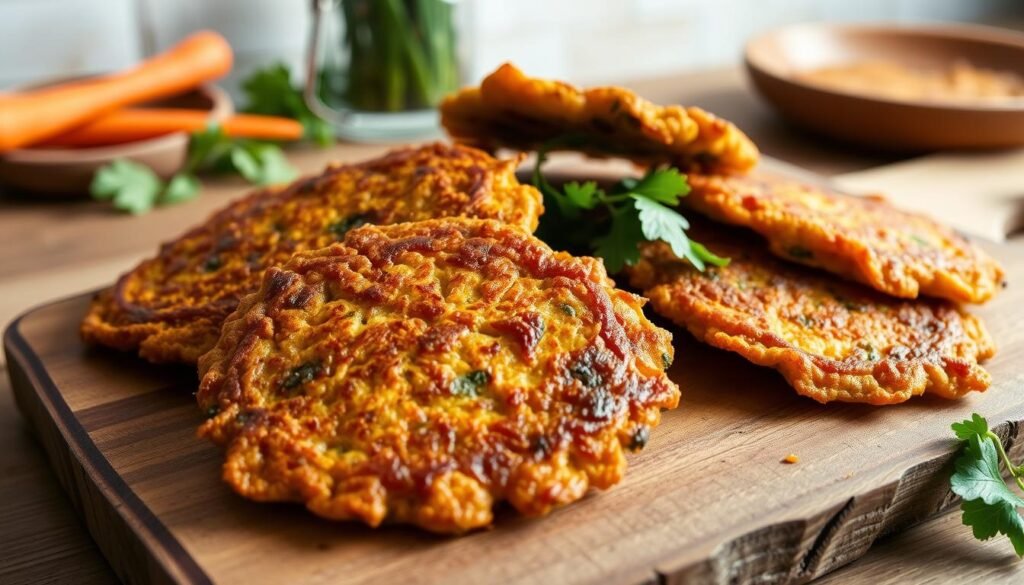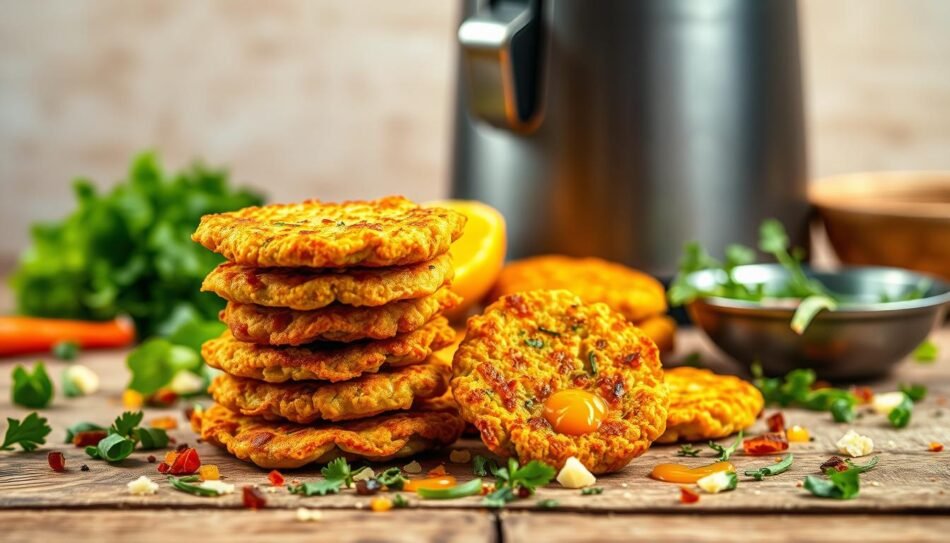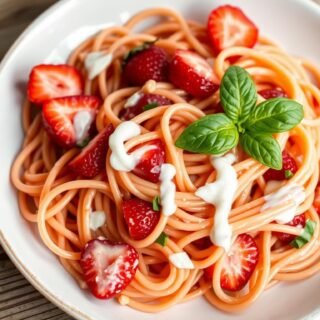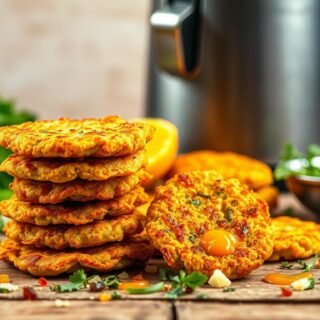Discover how to make Crispy Juicer Pulp Fritters | Zero-Waste Snacks in 15 Minutes. A quick, easy, and delicious way to reduce kitchen waste.
Are you tired of throwing away valuable nutrients with your juicer pulp? You’re not alone. Many of us struggle to consume the recommended amount of fruits and veggies, resulting in a significant amount of waste. The good news is that with a little creativity, you can turn this waste into a delicious and healthy snack.
Crispy Juicer Pulp Fritters | Zero-Waste Snacks in 15 Minutes
The leftover pulp from your juicing routine is packed with fiber, which can keep you fuller for longer. By repurposing this pulp, you can create a tasty and nutritious snack that not only reduces kitchen waste but also maximizes the nutritional benefits of your juicing efforts.
Key Takeaways
- Transform your juicer pulp into crispy fritters in just 15 minutes.
- Reduce kitchen waste while creating a nutritious snack rich in fiber.
- Customize your fritters with different herbs and spices to complement your juice.
- Make the most of your time and ingredients in the kitchen with this simple recipe.
- Enjoy a zero-waste approach that saves you money and reduces environmental impact.
The Problem with Juicer Pulp Waste
As more people turn to juicing for a quick nutritional boost, they’re faced with a growing problem – what to do with the leftover pulp. The average American consumes far fewer fruits and vegetables than recommended, creating a significant health challenge across the country.
Why Americans Struggle to Consume Enough Fruits and Vegetables
Many people turn to juicing as a convenient solution to increase their intake of essential nutrients without having to eat large quantities of produce. Despite its nutritional benefits, juicing creates a substantial waste problem in the form of leftover pulp that often gets thrown away.
- The juicing trend has grown substantially in recent years, with both commercial juice bars and home juicing becoming increasingly popular.
- This discarded juice pulp represents valuable fiber and nutrients that could otherwise contribute to a healthy diet.
The Growing Popularity of Juicing and Its Waste Problem
The environmental impact of juice pulp waste is considerable when multiplied across millions of households and businesses. Creating a zero waste approach to juicing can save time and money while helping reduce the environmental footprint of this healthy habit.
- Fruits and vegetables like carrots produce especially nutrient-rich pulp that deserves to be repurposed rather than discarded.
- By finding creative ways to use juicer pulp, individuals can make the most of their juicing efforts while minimizing waste.
Crispy Juicer Pulp Fritters | Zero-Waste Snacks in 15 Minutes
With the simple recipe for crispy juicer pulp fritters, you can create a delicious zero-waste snack in just 15 minutes. This innovative approach to using juice pulp not only reduces waste but also provides a nutritious snack rich in fiber.

Understanding the Nutritional Value of Juice Pulp
Juice pulp is primarily composed of dietary fiber, which plays a crucial role in digestive health and helps you feel fuller for longer periods. The nutritional profile of your fritters will vary depending on the produce you juiced. For instance, carrot pulp provides beta-carotene, while leafy green pulp offers minerals and phytonutrients.
Best Types of Pulp for Making Fritters
Vegetable pulps like carrot, celery, and spinach tend to work best for savory fritters, creating a versatile base that accepts various seasonings. Carrot pulp is particularly versatile due to its natural sweetness and sturdy fiber content that holds together well during cooking.
Why These Fritters Are Perfect for Busy People
These zero-waste fritters can be prepared in just 15 minutes, making them an ideal solution for busy individuals looking for quick, nutritious snacks. The recipe is designed to be simple enough for beginners while producing consistently crispy results that satisfy as a snack or side dish. You can find the detailed recipe on Glow Kitchen’s website.
- Juice pulp is rich in dietary fiber, aiding digestive health.
- The nutritional value of fritters varies with the juiced produce.
- Carrot pulp is a versatile option for fritters.
- These fritters are quick to make and perfect for busy lifestyles.
Step-by-Step Recipe Instructions
Turning your juice pulp into crispy fritters is a straightforward process that requires just a few ingredients and some basic cooking techniques. This recipe is highly customizable and can be adapted to suit your taste preferences.
Ingredients List
To make these delicious fritters, you’ll need the following ingredients:
- 1 cup of green juice pulp (from celery and spinach)
- 2 large raw eggs
- 1/4 cup of almond flour
- 0.5 tsp of salt
- 0.5 tsp of onion powder
- 0.5 tsp of garlic powder
- 0.25 tsp of paprika
- 2 tbsp of extra virgin olive oil
- 1 slice of lemon (1/8 of a medium lemon)
You can also customize the recipe by adding fresh herbs or adjusting the seasonings to complement the specific type of pulp you’re using. For example, carrot pulp pairs well with cumin, while celery pulp works nicely with dill.
Mixing the Batter
To mix the batter, simply combine the juice pulp, eggs, almond flour, garlic powder, onion powder, paprika, and salt in a large bowl. Mix everything together until it’s well incorporated. The batter should be thick but still manageable; if it’s too dry, you can add a little more egg or some water.

Cooking Techniques for Perfect Crispiness
To achieve perfect crispiness, heat the olive oil in a non-stick pan over medium-low heat. Using a cookie scoop, portion out the batter and flatten each portion with your palms before placing it in the pan. Cook the fritters in batches of 3-4 at a time to avoid overcrowding the pan. Each fritter needs approximately 2-3 minutes per side, resulting in a golden-brown exterior while maintaining a moist interior.
Serve the fritters immediately after cooking for the best texture and flavor experience. You can garnish with lemon slices and drizzle with ranch dressing or tahini sauce if desired.
Conclusion: Beyond Fritters – Other Ways to Use Juice Pulp
The versatility of juice pulp is a game-changer for those looking to minimize food waste. You can repurpose leftover pulp in a variety of dishes, making your kitchen more sustainable.
Beyond making fritters, you can incorporate juice pulp into pancake batter, add it to burger patties for extra flavor, or simmer it into stocks and sauces. Carrot and celery pulp can add depth to these kitchen staples. You can also make quick soups by combining vegetable pulp with low-sodium stock and leftover protein.
Other creative uses include adding pulp to baked goods like breads and muffins, hiding it between layers of cheese in lasagna, or making crackers from dehydrated juice pulp. For more ideas, you can visit various websites that offer recipes specifically designed for leftover juice pulp, helping you achieve a zero-waste kitchen.










Pingback: Homemade Nixtamal Tortillas: A Delicious Tradition